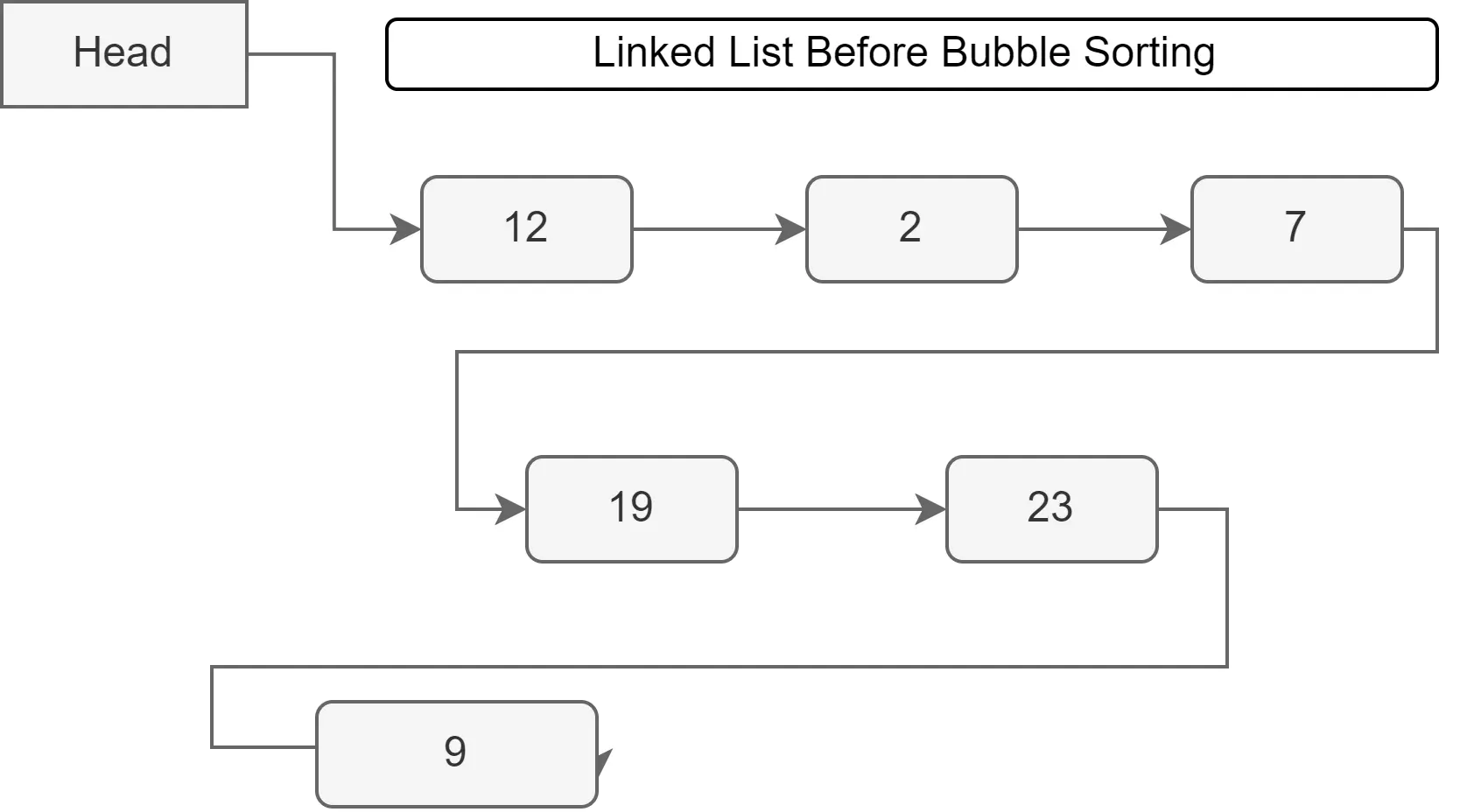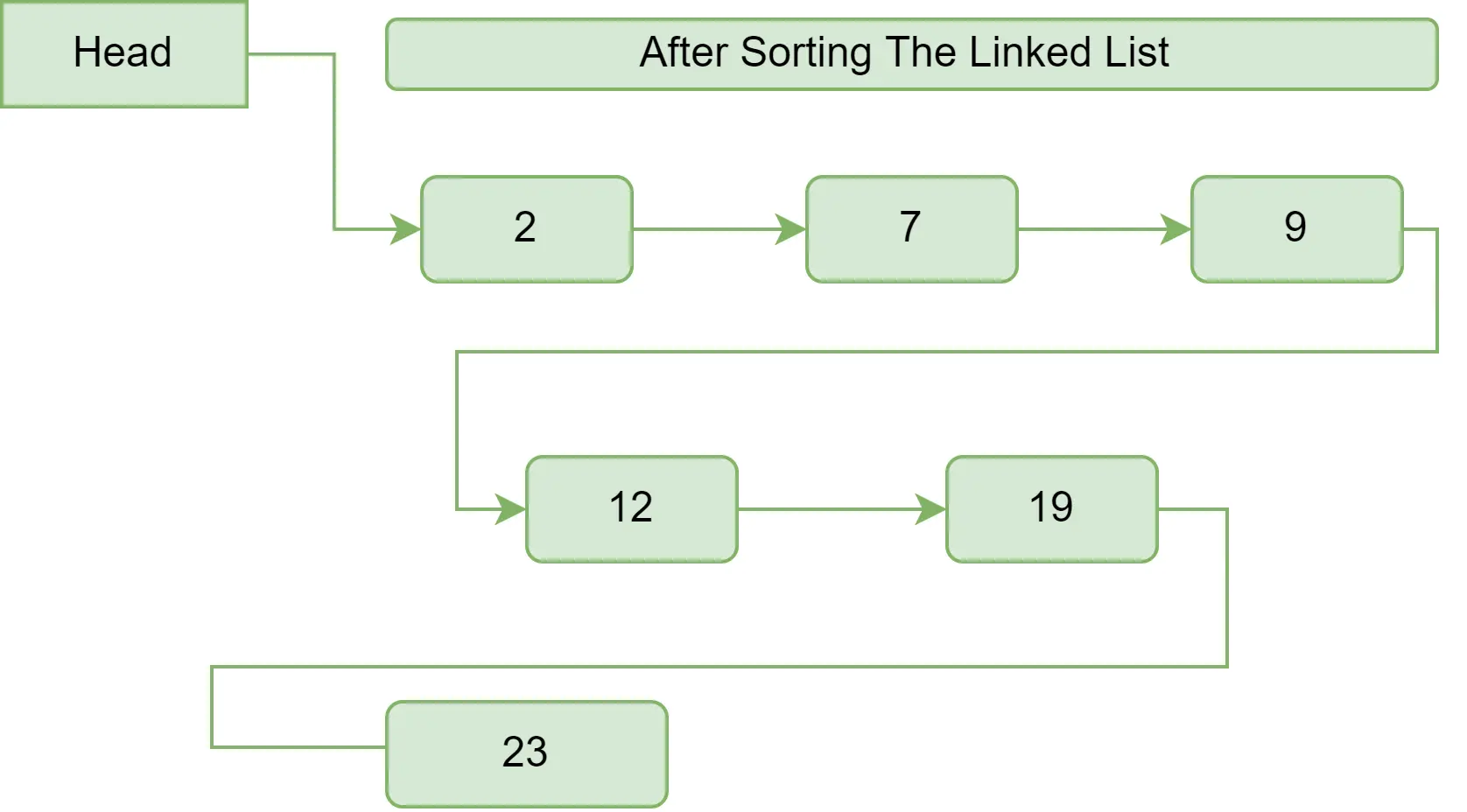Java에서 버블 정렬 알고리즘을 사용하여 수동 연결 목록 정렬

버블 정렬은 데이터 수집을 정렬하는 데 사용되는 가장 일반적인 데이터 구조 알고리즘입니다. 인접 요소가 정확할 때까지 잘못된 순서로 반복하고 교체하여 작동합니다.
먼저 기본적인 정렬 데모를 보여드리겠습니다. 그런 다음 Java에서 연결 목록을 정렬하기 위해 두 가지 버블 정렬 알고리즘을 구현합니다.
Java의 버블 정렬
정렬의 산술적 측면에 빠지지 않고 필수 사항을 유지합시다. 버블 정렬에서 처음부터 최종 색인까지 배열을 탐색합니다.
그러면 현재 색인을 다음 색인과 비교할 수 있습니다. 이 공식의 핵심 개념은 현재 요소가 다음 요소보다 크기가 커질 때입니다.
통사론:
for (int A = 0; A < sort - 1; A++)
for (int B = 0; B < sort - A - 1; B++)
if (DEMO[B] > DEMO[B + 1]) {
// Swapping of array
int temp = DEMO[B];
DEMO[B] = DEMO[B + 1];
DEMO[B + 1] = temp;
}
이제 Java에서 간단한 버블 정렬 알고리즘을 실행해 보겠습니다. 그러나 먼저 배열의 정렬되지 않은 인덱스의 초기 상태를 살펴보십시오.
배열: {43, 65, 21, 64, 12, 6, 1}
다음 코드 블록은 이 기본 정렬 알고리즘을 적용하여 이 배열 인덱스에 대해 버블 정렬을 수행합니다.
요구 사항에 따라 이 공식을 항상 수정할 수 있습니다. 그러나 핵심은 이 순간에 명확성을 형성하기 위해 기본적으로 남아 있어야 합니다.
암호:
// In this program, we will sort an array DEMO using the bubble sort algorithm
// Main class
public class BubbleSortLinkListExample1 {
// Main function
private void bubbleSort(int DEMO[]) {
// Using .length to determine entire length of array's index
int sort = DEMO.length;
// If array's length is less than int sort, increase it by 1
for (int A = 0; A < sort - 1; A++)
// Formula 1
for (int B = 0; B < sort - A - 1; B++)
if (DEMO[B] > DEMO[B + 1]) {
// Swapping of array
int temp = DEMO[B];
DEMO[B] = DEMO[B + 1];
DEMO[B + 1] = temp;
}
}
/* Now we are going to print DEMO array*/
void printArray(int DEMO[]) {
int sort = DEMO.length;
for (int A = 0; A < sort; ++A) System.out.print(DEMO[A] + " ");
System.out.println();
}
// We are going to implement a driver algorithm for sorting our DEMO array
public static void main(String args[]) {
BubbleSortLinkListExample1 ob = new BubbleSortLinkListExample1();
int DEMO[] = {43, 65, 21, 64, 12, 6, 1};
ob.bubbleSort(DEMO);
System.out.println("After the array has been sorted!");
ob.printArray(DEMO);
}
}
이 배열을 오름차순으로 정렬한 후 Java의 출력을 얻습니다.
출력:
After the array has been sorted!
1 6 12 21 43 64 65
Java의 버블 정렬 수동 연결 목록
연결 목록 수동 정렬도 버블 정렬의 간단한 방법입니다.
이전에 데이터 탐색에 대해 논의한 적이 있습니까? 이제 실천해 보겠습니다.
노드를 사용하면 한 노드에서 다음 노드로 데이터를 이동할 수 있습니다.
아래 데모 모델을 살펴보십시오. 이전 예제에서 정렬을 수행했으므로 여기서 노드를 강조하는 것이 중요합니다.

Java의 클래스 정렬 연결 목록
이해했듯이 이 클래스를 적용하여 Java에서 노드를 형성합니다.
암호:
class SortLL {
public static class Mynode {
int indx;
Mynode fwdMynode;
public Mynode(int indx) {
this.indx = indx;
this.fwdMynode = null;
}
public int getindx() {
return this.indx;
}
}
.setNextNode() 함수도 사용할 것입니다.이러한 클래스를 별도로 사용하고 해당 개체를 호출할 수 있지만 이는 길고 복잡한 방법입니다. 따라서 모든 클래스를 하나의 파일에 보관했습니다.
마찬가지로 .getNextNode() 함수를 사용하여 인수 없이 다음 클래스 요소를 검색합니다. 개념에 익숙해야하므로 더 이상 고민하지 않고 수동 버블 정렬 알고리즘을 실행해 보겠습니다.
-
정렬 전 연결 목록:

암호:
```java
class SortLL {
public static class Mynode {
int indx;
Mynode fwdMynode;
public Mynode(int indx) {
this.indx = indx;
this.fwdMynode = null;
}
public int getindx() {
return this.indx;
}
}
// My node class
private Mynode head;
private int size;
public SortLL() {
this.head = null;
this.size = 0;
}
public void add(int indx) {
Mynode Mynode = new Mynode(indx);
if (head == null) {
head = Mynode;
} else {
Mynode CN = head;
while (CN.fwdMynode != null) {
CN = CN.fwdMynode;
}
CN.fwdMynode = Mynode;
}
size++;
}
public void sort() {
if (size > 1) {
boolean dtr;
do {
Mynode thisMynode = head;
Mynode ladtMynode = null;
Mynode fwd = head.fwdMynode;
dtr = false;
while (fwd != null) {
if (thisMynode.indx > fwd.indx) {
dtr = true;
if (ladtMynode != null) {
Mynode sig = fwd.fwdMynode;
ladtMynode.fwdMynode = fwd;
fwd.fwdMynode = thisMynode;
thisMynode.fwdMynode = sig;
} else {
Mynode sig = fwd.fwdMynode;
head = fwd;
fwd.fwdMynode = thisMynode;
thisMynode.fwdMynode = sig;
}
ladtMynode = fwd;
fwd = thisMynode.fwdMynode;
} else {
ladtMynode = thisMynode;
thisMynode = fwd;
fwd = fwd.fwdMynode;
}
}
} while (dtr);
}
}
public int listSize() {
return size;
}
public void printindx() {
Mynode CN = head;
while (CN != null) {
int indx = CN.getindx();
System.out.print(indx + " ");
CN = CN.fwdMynode;
}
System.out.println();
}
public boolean isEmpty() {
return size == 0;
}
}
// indxInterface class
class SrtBubb {
public static void main(String[] args) {
SortLL s = new SortLL();
s.add(12);
s.add(2);
s.add(7);
s.add(19);
s.add(23);
s.add(9);
System.out.println("Before Performing Bubble Sort");
s.printindx();
s.sort();
System.out.println("After Performing Bubble Sort");
s.printindx();
System.out.println("Size of the linked list is: " + s.listSize());
}
}
```
-
수동 버블 정렬을 수행한 후:

출력:
Before Performing Bubble Sort 12 2 7 19 23 9 After Performing Bubble Sort 2 7 9 12 19 23 Size of the linked list is: 6
요구 사항에 따라 이 프로그램을 수정할 수 있습니다. 그러나 이것은 버블 정렬을 사용하여 연결 목록을 수동으로 정렬하는 방법을 초보자가 이해하는 가장 실용적인 방법입니다.
이 주제에 대해 여전히 혼란스럽다고 가정합니다. 파일 디렉토리에 코드도 제공했습니다.
Sarwan Soomro is a freelance software engineer and an expert technical writer who loves writing and coding. He has 5 years of web development and 3 years of professional writing experience, and an MSs in computer science. In addition, he has numerous professional qualifications in the cloud, database, desktop, and online technologies. And has developed multi-technology programming guides for beginners and published many tech articles.
LinkedIn